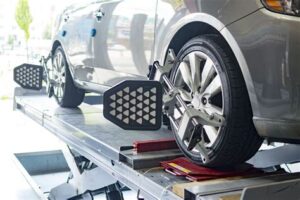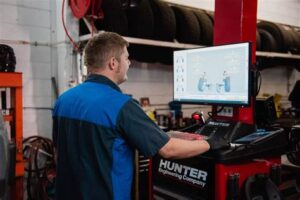Discover the significance of car alignment, its effects, signs of misalignment, benefits of alignment machines, and types of equipment for optimal performance.When it comes to ensuring a smooth and safe driving experience, proper car alignment plays a pivotal role. However, many drivers overlook this crucial aspect of vehicle maintenance. Misaligned wheels can lead to a host of problems, from uneven tire wear to compromised handling, ultimately affecting both performance and safety. In this blog post, we will explore the importance of car alignment, the negative effects of misaligned wheels, and the telltale signs that indicate your vehicle may need realignment. We’ll also discuss the benefits of utilizing advanced alignment machines and highlight the various types of car alignment equipment available. By understanding these factors, you’ll be equipped to maintain your vehicle’s optimal performance and prolong its lifespan. Let’s dive in!
Importance of Car Alignment
Maintaining proper car alignment is crucial for the overall performance and safety of your vehicle. When the wheels of your car are aligned correctly, it helps ensure that all four tires are making proper contact with the road. This not only improves driving stability but also affects your vehicle’s handling and braking capabilities.
A well-aligned vehicle contributes to better fuel efficiency. When your wheels are misaligned, your engine has to work harder to move your car, leading to decreased fuel economy. This is especially significant considering the rising fuel prices affecting all drivers today. Regular alignment checks can help you save money in the long run.
Moreover, car alignment plays a vital role in tire longevity. Incorrectly aligned wheels can cause uneven tire wear, resulting in the need for premature tire replacements. By ensuring your wheels are correctly aligned, you not only enhance your driving experience but also prolong the life of your tires.
Effects of Misaligned Wheels
When it comes to ensuring a safe and comfortable driving experience, the alignment of your car’s wheels plays a crucial role. Misaligned wheels can have a cascade of negative effects, impacting not just the vehicle’s performance but also its safety and your wallet.
One of the most noticeable effects of misaligned wheels is uneven tire wear. When your wheels are not properly aligned, they can cause some sections of the tire to wear down faster than others. This leads to premature tire replacement, which can be a significant expense for car owners.
In addition to affecting tire longevity, misalignment can also result in poor handling and steering stability. Drivers may notice that the car pulls to one side or requires constant adjustments to maintain a straight path. This lack of control can be dangerous, especially in high-speed situations.
| Effect | Description |
|---|---|
| Uneven Tire Wear | Leads to premature wear on tires, causing unexpected replacement costs. |
| Poor Handling | Results in the car pulling to one side and difficulty in steering control. |
| Increased Fuel Consumption | Misalignment forces the engine to work harder, consuming more fuel. |
Another significant consequence of misaligned wheels is increased fuel consumption. When your vehicle is pulling to the side, the engine has to work harder to overcome this resistance, leading to higher fuel usage and costs over time.
Overall, it is vital to recognize the effects of misaligned wheels and address alignment issues promptly. Regular inspections and adjustments can prevent many of these issues, saving you
Signs of Poor Wheel Alignment
Proper wheel alignment is essential for the safety and performance of your vehicle. When wheels are misaligned, it can lead to various issues that not only affect how your car drives but can also compromise your safety on the road. Here are some common signs of poor wheel alignment you should be aware of:
- Uneven Tire Wear: One of the most noticeable signs of misalignment is uneven tire wear. If you notice one side of your tires wearing down faster than the other, it’s a clear indication that your wheels are misaligned.
- Pulling to One Side: If your car tends to pull to the left or right while driving straight, it could signify that your wheels are not aligned properly.
- Steering Wheel Off-Center: A crooked steering wheel when driving straight is another telltale sign of poor alignment. If your steering wheel is not centered, it indicates that your wheels are misaligned.
- Vibration in the Steering Wheel: Feeling vibrations in the steering wheel can also be a signal of wheel alignment issues. Misalignment can cause inconsistent tire contact with the road, leading to vibrations.
- Reduced Fuel Efficiency: Misalignment can cause your vehicle to work harder to move in a straight line, leading to reduced fuel efficiency. If you notice an unexpected drop in your miles per gallon, your wheel alignment may be to blame.
It’s crucial to monitor these indicators and address them promptly. Ignoring the signs of poor wheel alignment can result in serious damage to your vehicle, including costly repairs and compromised safety.
If you experience any of these signs, it’s a good idea to consult with a professional mechanic. They can assess the alignment of your wheels and recommend the necessary actions, ensuring that you enjoy a safe and comfortable driving experience.
Incorporating regular checks for wheel alignment as part of your vehicle maintenance routine can help you avoid these issues. Remember, timely attention can save you money and enhance the lifespan of your tires and overall vehicle performance.
Benefits of Using Alignment Machines
Using alignment machines comes with numerous benefits that significantly enhance the performance and longevity of your vehicle. These machines are designed to ensure that your wheels are properly aligned, which is crucial for optimal vehicle operation. Below are some of the key advantages of utilizing these advanced systems.
One of the primary benefits of using alignment machines is improved fuel efficiency. When your wheels are aligned correctly, your vehicle doesn’t have to work as hard to move forward. This reduced strain results in better gas mileage, ultimately saving you money at the pump.
Additionally, alignment machines help extend the life of your tires. Misaligned wheels can cause uneven tire wear, leading to the premature need for replacements. By regularly checking and adjusting your wheel alignment with professional machinery, you can enjoy longer-lasting tires and a smoother ride.
Another advantage is enhanced vehicle safety. Proper alignment ensures that your car tracks straight on the road, minimizing the likelihood of skidding or losing control. Additionally, it contributes to better handling and braking responsiveness, which are essential aspects of driving safety.
In summary, investing in high-quality alignment machines can lead to numerous benefits, including improved fuel efficiency, extended tire life, and enhanced safety while driving.
Types of Car Alignment Equipment
When it comes to maintaining the performance of your vehicle, ensuring proper alignment of your wheels is essential. There are various types of car alignment equipment available, each designed for specific tasks and levels of precision. Understanding these tools not only helps improve the accuracy of wheel alignment but also contributes to better driving safety and vehicle longevity.
Here are some of the most common types of car alignment equipment used in automotive service centers:
| Equipment Type | Description |
|---|---|
| 2D Wheel Alignment Machines | These machines provide basic alignment measurements and are suitable for standard vehicles. They use cameras or lasers to calculate angles and adjust accordingly. |
| 3D Wheel Alignment Machines | These advanced machines use three-dimensional imaging to provide highly accurate measurements, allowing for precise adjustments. They are ideal for modern vehicles with advanced suspension systems. |
| Alignment Racks | These stationary platforms help technicians access the vehicle’s undercarriage easily. They are commonly used alongside other equipment. |
| Camber/Caster Gauges | These handheld devices measure the camber and caster angles of wheels and are crucial for fine-tuning alignments. |
| Toe Plates | Simpler than other equipment, toe plates help measure and adjust the toe angle of the tires quickly and efficiently. |
Using the right car alignment equipment not only improves the accuracy of adjustments but also enhances the overall performance of your vehicle. Technicians equipped with high-quality tools can diagnose issues faster and provide solutions that last longer, ensuring a smoother ride.
Investing in modern alignment machines can lead to a noticeable improvement in the service offered by automotive shops. Customers appreciate quicker service times and a more reliable vehicle after appropriate alignments. Remember to regularly check your wheel alignment to avoid uneven tire wear and maintain optimal control while driving.
Frequently Asked Questions
What is a car alignment?
Car alignment refers to the adjustment of a vehicle’s suspension system, ensuring that the wheels are positioned correctly relative to each other and the road.
Why is proper alignment important for a car?
Proper alignment is crucial for maximizing tire life, improving vehicle handling, enhancing fuel efficiency, and ensuring overall driving safety.
How often should I get my car aligned?
It is recommended to get your car aligned every 6,000 miles, or if you notice uneven tire wear, steering issues, or after hitting a pothole.
What are the signs that my car needs alignment?
Common signs include uneven tire wear, the vehicle pulling to one side while driving, steering wheel off-center, and vibration in the steering wheel.
Can misalignment cause damage to my vehicle?
Yes, misalignment can lead to faster tire wear, suspension issues, and even affect the braking system over time.
Is a car alignment the same as a wheel balancing?
No, wheel alignment adjusts the angles of the wheels, while wheel balancing ensures that the weight is evenly distributed across the wheel-tire assembly.
How is a car alignment performed?
A car alignment is performed using specialized equipment that measures the angles of the wheels, followed by adjustments to the suspension components to achieve the desired alignment specifications.





